Exploring Avian and Exotic Species: A Care Guide

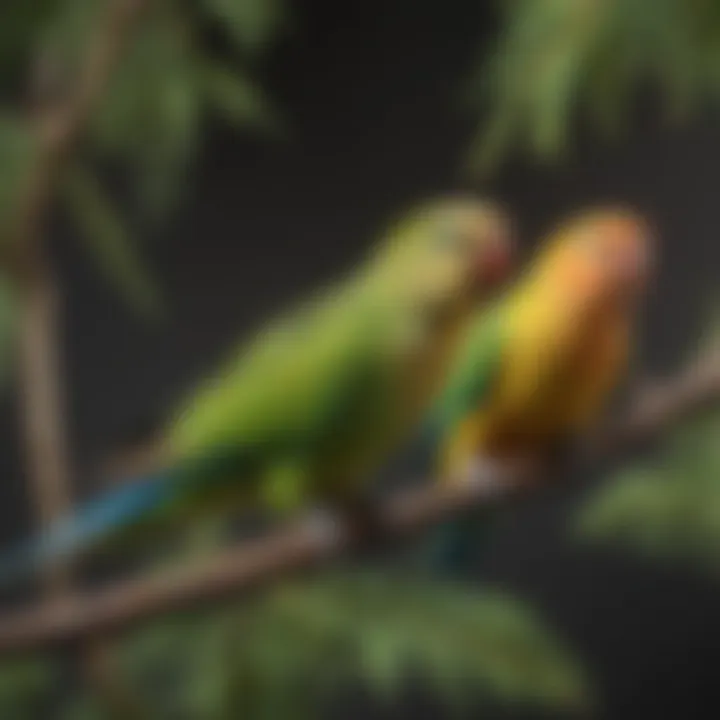
Intro
Navigating the world of pet birds requires a dive into their specific needs. Each species is unique, presenting its own set of characteristics and mandatory husbandry. The intention of this guide is simple yet profound: to present you with critical insights that aid in understanding how to nurture a harmonious relationship with your feathered companions. By shedding light on the essentials of bird care, behavior, nutrition, and health, we strive to empower bird enthusiasts.
Care Tips
Taking proper care of pet birds is not just essential; it is a labor of love. Daily routines often define the quality of life a bird experiences. Establishing a rigorous daily care regimen tailored to the needs of each species creates a conducive atmosphere for both owner and bird. Here are several fundamental routines.
Daily Care Routines
Engaging with your bird consistently is crucial. Begin each day by providing fresh water and a balanced breakfast. Mistakenly skipping this step can impair their health. Active interaction—with both play and training sessions—adds to their daily stimulation.
A daily ritual can include:
- Feeding: Specific seeds and pellets based on the species’ dietary needs.
- Cleaning: Checking their living spaces for waste and removing it regularly.
- Socialization: Give time for play and interaction, crucial for avian intellect and bonds.
Cage Setup and Maintenance
A well-maintained cage is vital. As the sanctuary for your pet bird, the cage needs to be larger than minimally required. Placement is also key—avoid stressing them with high traffic areas. Each location comes with its own demands in terms of exposure to sunlight and temperature control.
Important checks include:
- Ensuring all perches are secure and adequately spaced.
- Regularly assessing the integrity of toys and accessories.
Hygiene and Cleaning Practices
Birds thrive in clean environments. A systematic cleaning schedule will ensure a healthy enclosure. Swap out perch liners weekly and sanitize food and water containers frequently.
Seasonal Care Adjustments
Bird care is not static but involves adaptations for seasonal changes. Winters may require extra heating while summers necessitate ventilation. It’s prudent to observe temperature and humidity levels. Adjust schedules accordingly to reflect ambient condition to sustain your pet's health.
Behavioral Insights
Understanding bird behavior unlocks their needs. As intelligent creatures with unique personalities, grasping their mannerisms enhances your ability to create effective interaction norms.
Understanding Bird Body Language
Birds communicate largely through body language. Subtle shifts in posture or feather positioning convey messages on comfort or distress. Simple signs like a relaxed stance indicate happiness, while ruffled feathers may suggest they feel threatened.
Common Behavioral Issues and Solutions
Behavioral issues often arise from boredom or improper environments. These conditions can result in screaming, aggression, or feather plucking. Identifying underlying causes is critical. Would lack of stimulation prompt an unwanted reaction? Consider diversifying their activities.
Positive Reinforcement Techniques
Utilizing positive reinforcement is key for behavior modification. Simple treats can be highly motivating to birds. Training must rely on patience and consistency to produce measurable success over time.
Social Interaction Needs
Birds are inherently social animals. They require regular interaction, not only with their owners but, when possible, with other birds. Isolation may lead to stress and related health issues. Taking time daily can forge deeper bonds.
Nutrition Guides
Proper diet fuels health and vitality for pet birds. Understanding dietary balance and risks associated with common foods is fundamental for avian care.
Essential Diet Components
A varied, high-quality diet should consist of seeds, pellets, vegetables, and even fruits based on preferences and nutritional needs. Proteins from legumes or cooked grains also play a role.
Safe and Toxic Foods
Some foods are inherently toxic to birds, leading to severe health complications. ongs:
- Avocado
- Chocolate
- Caffeine
- Alcohol
Conversely, it’s equally crucial to identify safe dietary options, promoting a balanced diet.
Supplements and Treats
Providing nutritious treats or supplements can contribute positively to a bird’s joie de vivre. Look for specific brands such as Bene-Bac or AVIx. Such offerings should support their overall well-being and immunity.
Feeding Strategies for Different Species
Consider species diversity when planning diets. Some birds may require more protein while others need higher seed varieties for health. Consult a vet for a tailored plan appropriate to the species in sight.
Wellness and Health
Regular health protocols define well-being. Proactive measures can help mitigate various health issues before they escalate.
Routine Health Checkups
Regular health evaluations from a veterinarian specializing in avian species facilitate early detection of health concerns. Make this a part of their annual routine.
Identifying Symptoms of Illness
Physical signs can denote impending health issues. Acute vigilance is necessary. Look for changes in eating habits, droppings, or general demeanor affecting daily actions.
Preventative Care and Vaccinations
Preventative medicine remains crucial in bird care. Vaccination flows also often enhance avian resilience. Propose suitable vaccines based on your ehrlich avian vet's direction.
Mental and Emotional Well-being
Birds possess emotional core that influences behavior. Routine social interaction correlates directly with an increase in happiness and reduced behavioral issues. Prioritize actions enriching both mental engagement and fulfillment in these lovely creatures.
Enriching Activities
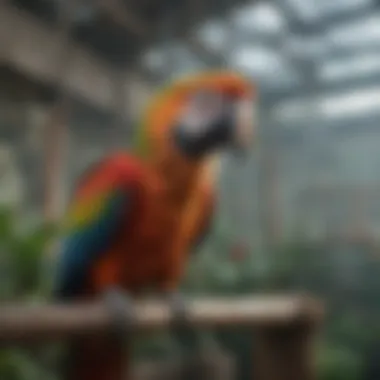
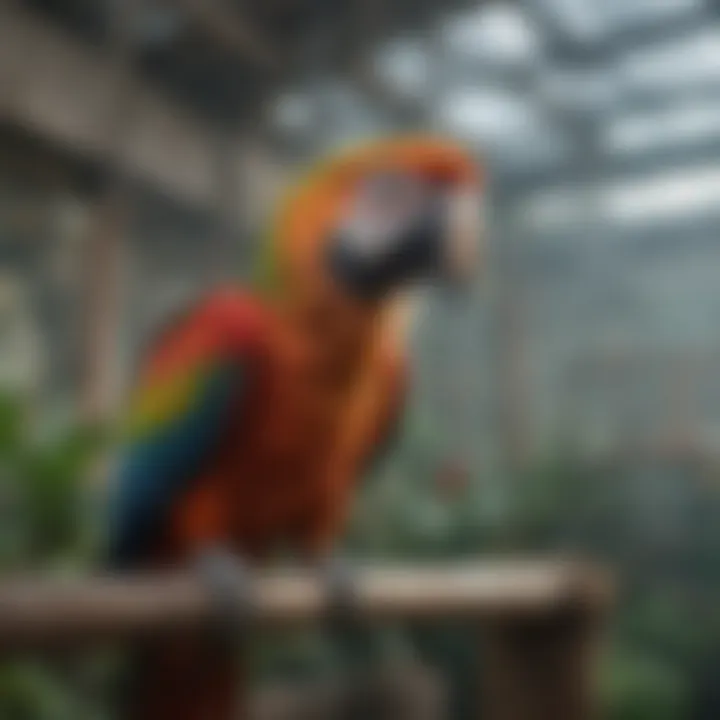
Engagement through activities maximizes happiness levels for pet birds. Enrichment drives creativity while ensuring a sound lifestyle—assessment into their inherent curiosities matters most.
Toys and Playtime Ideas
Offer varied toys that promote playful behavior pushing their creativity. Things could range from bells and balls to larger dimensions that stand uniquely challenge aspects to ascertain environmental buffering activities.
Training and Tricks
Teaching commands and tricks inspires both mental and emotional growth. Use shaping techniques with gaze-enhancement strategies, accompanying training process maintaining an insightful balance.
Outdoor Activities and Interaction
Supervised outings expose pet birds to broader stimuli. Plan excursions virtualizing exploration spikes through birds' domains fortifying experiences. Avoid overstressing them during their exposure periods.
DIY Projects for Mental Stimulation
Fortifying knowledge dives into the capability for various Do-It-Yourself projects any audacious feathered friend can indulge themselves in—engagement sequences hinging outwardly expanding behavioral foundations!
Understanding the diverse landscape of avian needs is crucial for fostering long-lasting bonds with pet birds. These commitments lead to healthier, happier lives enrichment. To ensure fulfillment and success in your journey, pursuing ongoing learning and adaptation is fundamental.
This exploration into the realm of avian companions hopes to serve as a resourceful guide, allowing anyone to embark upon the journey towards enriching these lives indeed!
Understanding Avian Species
Understanding avian species is a pivotal aspect of providing suitable and enriching care for pet birds. Different birds have unique traits and require specific environments, nutrition, and socialization strategies. Knowledge about various bird species will equip both current and aspiring bird owners with the tools to cater to their needs, thereby fostering a bond based on trust and connection. Additionally, comprehending the functions of instinctual behaviors can influence how well a pet bird adapts to its home. Thus, an informed approach leads to successful cohabitation and enhances the bird’s welfare overall.
Characteristics of Popular Pet Birds
Pet birds often possess distinct characteristics that inform their care requirements and challenges. Typical avian companions include species such as parrots, canaries, and finches.
- Parrots: Known for their intelligence and engaging personality, some popular types include the African Grey, Cockatiel, and Macaw. Parrots generally require a social environment and mental stimulation to thrive. Their ability to mimic human speech and sounds can also make them demanding, sometimes requiring dedicated time beyond simple cage activities.
- Canaries: These smaller birds, particularly appealing for their singing versatility, are single-minded and prefer solitary environments. They flourish when housed in quiet surroundings, which supports their delicate nature. Nutrition for canaries is vital as it influences their bright colors and vocal strength.
- Finches: Often seen in small flocks, finches are less demanding than some larger species. They require less attention and can be kept in adjacent pairs. Their interaction and playfulness convey a satisfaction correlating to a properly managed habitat.
The contemplation of size, behavior, compatibility, and even longevity is essential; choosing the right bird influences the daily care needed and enhances the overall experience of bird keeping.
Natural Habitats and Behavioral Traits
Natural habitats have a significant impact on a pet bird's behavior, underscoring the importance of replicating these environments in captivity. Birds tend to be influenced by their care practices, forming a critical aspect of the relationship they develop with owners.
- Tree Environments: Many species, such as those from the Amazonian rainforests, thrive in wooded areas, and their behavior often reflects this need for space and physical activity. Pet birds need climbing opportunities and perches similar to trees to ease their instinctual dances.
- Open Grasslands: Birds like canaries prefer spaces related to vast grasslands, showcasing behaviors that are less arboreal. Pet canaries benefit from wide cages that allow them to express their natural inclinations without feeling restricted.
Understanding natural rituals of various birds is instrumental. Effective care must involve simulating these behaviors through sufficient interaction and environmental aspects.
Exotic Birds: An Overview
Exotic birds attract a growing number of enthusiasts who are fascinated by their unique features and vibrant colors. Understanding these avian companions goes beyond mere aesthetics; it involves an understanding of their habitats, behaviors, and the challenges they face in the wild. An overview of exotic birds highlights their specific characteristics and conservation status, shedding light on their intrinsic needs while promoting responsible ownership and care. This section is crucial as it lays the groundwork for future sections that address selection, care, and welfare considerations for these extraordinary pets.
Defining Exotic Birds
Exotic birds typically refer to species that are not native to the local environment but are highly sought after by pet owners. This definition can span various families and genera, including parrots, finches, and canaries, each exhibiting distinct traits and colors. Some well-known exotic birds include the Green-cheeked Conure, the African Grey Parrot, and the Amazon Parrot.
What distinguishes exotic birds is more than their origin; it is their physiology and social behaviors. They tend to be more colorful and have vivid plumage, which is a primary reason they are popular among bird aficionados. Furthermore, many of these birds require specialized diets and care, which demands time and study from potential bird owners.
In summary, exotic birds offer not just visually stimulating pets but also demanding companions that need the right kind of environment, food, and interaction.
Conservation Status and Captive Breeding
The conservation status of many exotic bird species is alarming. Habitat destruction, poaching for the pet trade, and climate change contribute significantly to this troubling situation. Many species are classified as endangered or threatened, which raises serious concerns about biodiversity and ecological balance.
Captive breeding programs have emerged as a viable solution to aid in the conservation of endangered species. These programs aim to not only repopulate declining bird families but also educate the public about responsible ownership. Engaging with these initiatives can have several benefits for bird enthusiasts:
- Promoting Biodiversity: By supporting captive breeding, individuals can help populate the gene pool of certain species, thus bolstering their numbers in the wild.
- Responsible Practices: Breeders often provide birds that are well-socialized and raised in humane conditions. This practice can minimize the demand for wild-caught birds.
- Knowledge Sharing: Engaging in ethical bird ownership strengthens connections between the pet bird community and conservation initiatives, enriching the owner’s experience and encouraging responsible care.
Selecting the Right Bird
Selecting a pet bird is a significant commitment. The species you choose can define the experience of ownership for years. Different birds have varied needs in terms of environment, social interaction, and diet. Not all birds are suitable for every owner. Hence, understanding your potential pet is vital.
Factors to Consider
Before celebrating the arrival of a new bird, get ready. Here are the factors to evaluate when selecting the right bird:
- Species Size: Birds come in diverse sizes, from small canaries to larger macaws. Consider the amount of space you have.
- Noise Level: Some species are naturally loud, like cockatoos, while others, like finches, are quieter. Check how noise might affect your home environment.
- Activity Level: Different birds exhibit various energy levels. An active bird may require more space and stimulation.
- Social Structure: Some birds prefer companionship, while others may thrive alone. Assess how much time you can invest daily.
- Lifespan: Consider the bird's lifespan. Some birds, like parakeets, live around 10 years, while larger species can live for several decades. Understand that the choice impacts long-term responsibilities.
- Dietary Needs: Each species has specific diets. Assess how you want to fulfill those needs, accounting for cost and accessibility.
By reflecting on these key elements, you ensure a match that respects the bird's needs and your life situation.
Assessing Compatibility with Lifestyle
Choosing a bird also means assessing lifestyle compatibility. Adaptability is central. You should consider your own routine, family dynamics, and home environment. Questions to reflect upon include:
- Do you work long hours? Some birds may suffer from lack of interaction, potentially leading to behavioral issues.
- Is your space conducive for a bird? Open living rooms permit social interaction, but areas separated from daily activities may distress social birds.
- Are there young children or other pets around? Birds emay react differently to various environments and stimuli, leading to stress or aggression.
When you assess lifestyle compatibility, view both birds and your life constructively.
Understanding the balance between a bird's needs and your lifestyle promotes responsible pet ownership.
Nurturing Your Bird
Nurturing a pet bird is essential for its well-being and overall quality of life. Understanding how to meet the various needs of your avian friend requires both knowledge and effort. Several aspects require attention to help develop a strong bond while providing a safe and stimulating environment.
The primary aim of nurturing is to promote a healthy lifestyle, encouraging good mental and physical wellness. This includes creating an enriching environment that inspires natural behaviors, selecting appropriate cages and accessories, and ensuring consistent socialization. Each of these elements contributes significantly to your bird's happiness.
Creating an Enriching Environment
An enriching environment plays a vital role in making your bird thrive in a domestic setting. Birds, whether small or large, need stimulation to keep them occupied and engaged. They are naturally curious beings. Thus, the presence of diverse elements in their surroundings can aid in developing intelligence and enhancing good behaviors.
Elements to consider when creating such an environment include:
- Variety of Perches: Offer different diameters and textures, promoting healthy feet.
- Toys: Introduce a range of toys suitable for your bird’s size. Rotate them frequently to prevent boredom.
- Interactive Challenges: Consider puzzles or foraging toys that stimulate problem-solving abilities.
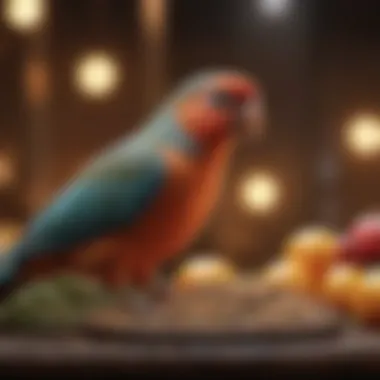
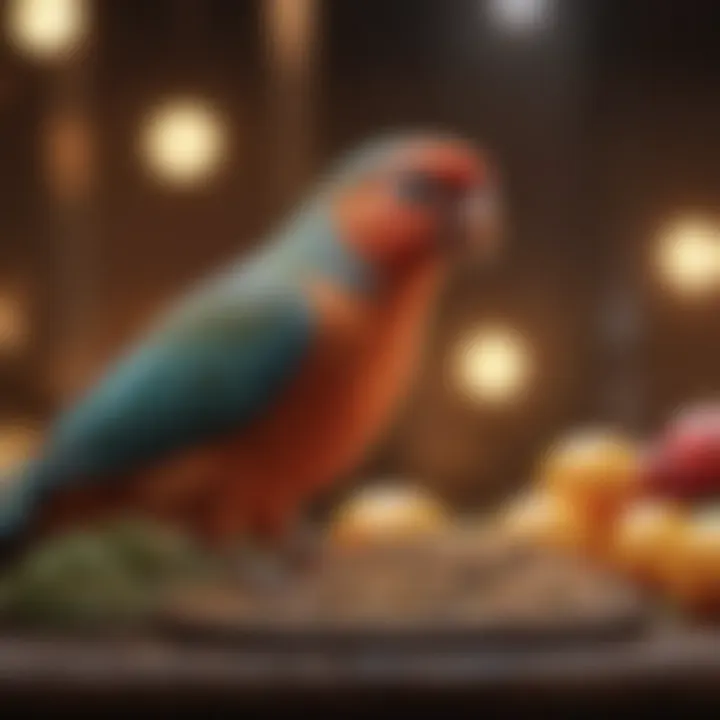
It's crucial to reassess the living space regularly, ensuring every aspect meets the activity levels expected of the species and individual personality.
Choosing the Right Cage and Accessories
The choice of cage is fundamental in nurturing your pet bird. An appropriate cage not only provides a safe space but also serves as a personal area where your bird retreats when needed. You must match the cage size to the species to avoid issues, as a cramped environment can lead to stress.
When opting for a cage, keep in mind:
- Dimensions: Wider cages may encourage flight movements and maneuvers. The minimum width should remain greater than the height for most birds.
- Material: Stainless steel and powder-coated cages can offer durability and safety. Avoid anything hazardous that could harm the bird.
- Accessibility: Ensure ease for entry and exit, along with multiple feeding stations that suit your routine.
Finally, do equip the cage with appropriate accessories. Regularly clean the cage to maintain hygiene. Overall, a thoughtful cage selection can significantly influence your bird's mood and physical fitness.
Importance of Socialization and Interaction
Socialization is more than mere interaction; it displays an understanding of your bird's behavior patterns. Birds are social creatures and need more than basics like food and shelter. Establishing connections with humans and preferably other birds contributes notably to emotional health.
Consider the follwoing approaches for effective socialization:
- Spend Time Together: Daily presence and talking aid your bird in feeling comfortable. Trust builds through routines.
- Training Sessions: Use simple commands or interactive games during their training to enhance communication and connection.
- Monitoring Body Language: Learn the signs your bird exhibits. Aggressive posture may warrant a reassessment of boundaries.
Effective first encounters lead to good associations with interactions. Socialization helps prevent behavioral issues, fostering a more satisfying companionship.
Engaging in nurturing methods createsa an enriching atmosphere, where pets can thrive based on their individual needs and behavior.
Overall, addressing every facet of nurturing helps in establishing a rewarding relationship between you and your bird. Through attentive care and commitment to these dynamics, it is possible to form a lasting bond that fosters mutual trust and respect.
Dietary Needs of Pet Birds
Understanding the dietary needs of pet birds is essential for their well-being. Just like humans and other pets, birds require a balanced diet to thrive. Proper nutrition supports their growth, boosts their immune system, and promotes vibrant plumage. When nutritional needs are met, pet birds show increased energy levels and better overall health. Finding the right approach to feeding is not only beneficial to the birds but also enhances the emotional bond between owners and their feathered companions.
Understanding Nutritional Requirements
Birds have unique dietary needs. These needs often differ based on species. Generally, a pet bird’s diet should include a mix of seeds, pellets, fruits, and vegetables. It is critical to note that not all birds can digest seeds well, though they are often a favorite among them.
Pellets can offer balanced nutrients, as they are formulated specifically for birds. Fruits and vegetables add important vitamins and fiber. It is advised to avoid processed foods or those high in sugar and fat, which could harm their health. Understanding which specific nutrients your pet bird requires helps provide a nourishing diet that supports their unique biological needs.
Recommended Diets for Specific Species
Different species of pet birds come with their own specific dietary requirements. Here’s a brief look at a few common pet bird species:
- Cockatiels: They thrive on a blend of pellets, seeds, fresh greens, and fruit.
- Parakeets (Budgies): These birds require a diet mainly of pellets with seed mixtures and occasional fresh produce.
- African Grey Parrots: Known for their intelligence, they need a mix of pellets and lots of fresh fruits and vegetables.
- Canaries: They do well on high-quality seeds, supplemented by greens and fresh treats to provide vitamins.
Understanding these needs helps in planning appropriate diets tailored to the species, enhaning their health and life quality.
Common Dietary Mistakes to Avoid
There are several common mistakes pet bird owners may inadvertently make when feeding their birds. Avoiding these can significantly improve your bird’s health:
- Over Reliance on Seeds: Seeds can be fatty and lack crucial nutrients, so they should not be the sole diet.
- Neglecting Fresh Foods: Not including fruits and vegetables leads to nutritional deficiencies.
- Feeding Processed Foods: Many commercial treats contain sugar and preservatives that are harmful.
- Ignoring Portion Sizes: Just like us, portion control is vital. Overfeeding can lead to obesity.
Proper attention to dietary needs can promote better longevity and quality of life for your pet birds.
By staying informed about pet birds' dietary needs, owners can play a crucial role in promoting their health and happiness.
Health and Wellness
Health and wellness are critical aspects of pet bird ownership. Understanding their needs contributes not only to the wellbeing of the birds, but also enhances the bond between pet and owner. By recognizing health issues early and providing proper care, owners can ensure their birds live longer and healthier lives. Knowledge about bird health includes not only physical health but also mental alertness and overall happiness. A healthy bird is an active bird whose behaviors reflect joy and curiosity.
Recognizing Common Health Issues
To maintain the overall wellbeing of pet birds, identifying common health issues is essential. Some frequent health problems include:
- Feather Plucking: Often a sign of stress, boredom, or medical conditions.
- Respiratory Problems: Signs like sneezing, wheezing, or difficulty breathing could indicate serious issues. Changes in vocalizations may also alert owners to potential health concerns.
- Digestive Disorders: Indications may include changes in droppings, lack of appetite, or vomiting. Feeding quality foods helps prevent these conditions.
- Obesity: Overweight birds may face additional health problems. Always monitor food intake and provide ample exercise opportunities.
It's imperative to observe birds closely. Recognizing nuances in behavior and health early often leads to effective treatment. A sudden change in activity or behavior might signal a problem. Bird owners are encouraged to keep a journal to track unusual signs or shifts in their pet's behavior.
Preventive Care and Veterinary Visits
Proactive healthcare is key when it comes to pet birds. Regular veterinary visits should be part of this care routine. Few fundamental considerations include:
- Annual Checkups: Scheduled visits to an avian veterinarian ensure health status monitoring and preventive measures against common diseases.
- Vaccination and Screenings: Avian physiotherapy includes knowledge of vaccines specific to bird health. Screening for diseases helps ensure long-term wellbeing.
- Maintaining Hygiene: Daily cleanings of cages and toys prevent the spread of disease. A clean habitat contributes greatly to a bird’s overall health.
Additionally, it is vital to educate oneself about avian-specific health concerns. Online resources, such as Wikipedia, provide useful information. Also, communities like Reddit and Facebook serve as platforms for sharing experiences and advice from other bird owners.
Regular check-ups and proper care not only detect illnesses early, but also offer owners peace of mind, knowing they prioritize their feathered companions' health and happiness.
By incorporating these elements into a regular pet care regimen, owners not only safeguard their birds' health but also emphasize the importance of wellness throughout their lives.
Behavioral Insights
Understanding the behavior of pet birds is crucial for their well-being and strengthing the bond between the owner and the bird. Birds are highly social creatures, and their behaviors can reveal much about their needs and feelings. This article will discuss the intricacies of bird communication and how to address common behavioral problems.
Understanding Bird Communication
Bird communication encompasses a range of sounds and actions. Each species has its own unique vocalizations, and it is important for owners to familiarize themselves with these sounds to interpret their birds' needs accurately. For example:
- Chirps and Whistles: Often indicate happiness or excitement.
- Screeching: Could suggest distress or a call for attention.
- Cooing: Typically a sign of contentment.
Body language in birds is equally meaningful. A relaxed stance, with ruffled feathers and a slightly open beak, often indicates calmness. Conversely, a puffed-up appearance can indicate aggression or discomfort. Paying attention to these signals serves to create a more harmonious environment.
By actively engaging with their birds through sounds and body movements, owners can foster better communication. This understanding can reduce anxiety both in the bird and its owner, making everyday interactions smoother.
Understanding a bird's form of communication is a key step in creating a healthy environment for both the owner and the pet.
Addressing Behavioral Problems
Behavioral issues can arise for a variety of reasons. They may stem from stress, boredom, or inadequate social interaction. It is essential for bird owners to identify the underlying causes to effectively address these problems. Here are common behavioral issues and approaches to solve them:
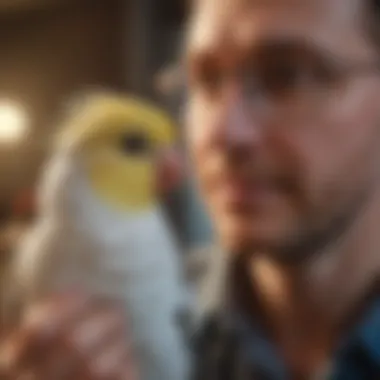
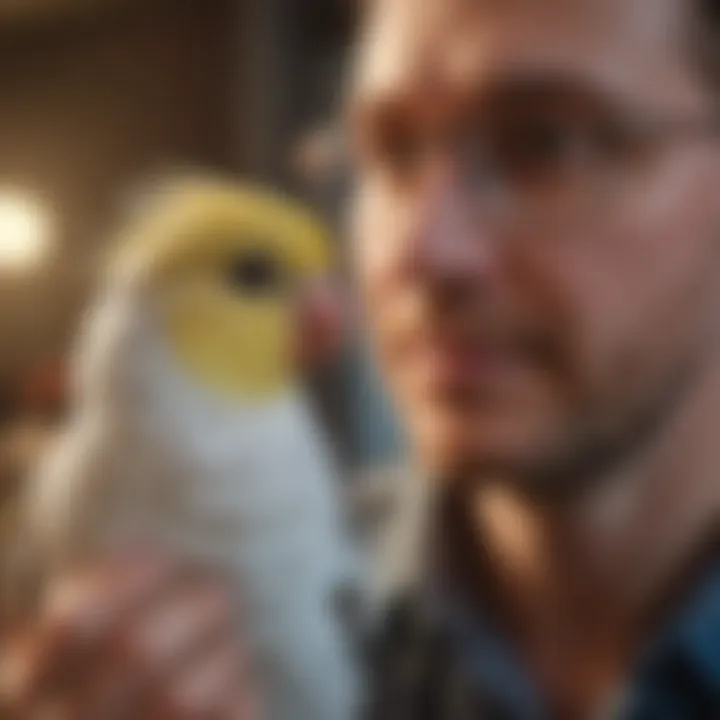
- Aggression: This may signify the need for a safe space. Avoid confrontational behaviors and provide a quiet area where the bird can retreat.
- Bitin or Pecking: Often a result of fear or frustration. Building trust through gradual socialization can make a difference.
- Excessive Screaming: Might indicate loneliness or lack of stimulation. Provide toys or additional interactions throughout the day.
Addressing these challenges requires patience and consistency. Engaging your bird in interactive play can alleviate boredom and reinforce appropriate social skills.
In summary, understanding behavioral insights provides invaluable tools for bird owners to foster better relationships with their pets, establishing trust and preventing issues before they escalate.
The Role of Enrichment Activities
Enrichment activities are a crucial aspect of bird care that often gets overlooked. These activities provide mental and physical stimulation, essential for the well-being of pet birds. Without appropriate enrichment, birds can become bored or exhibit destructive behavior. The responsibility of any bird owner includes ensuring their feathered companions have an engaging environment.
There are numerous benefits to incorporating enrichment activities into daily routines. Firstly, it can help in preventing behavioral issues. Birds that are mentally engaged tend to be more content and less likely to develop habits like excessive screeching or feather plucking. Enrichment also contributes significantly to their overall happiness, allowing them to exhibit their natural behavior more freely. Therefore, it is imperative that bird owners recognize enrichment not as an option, but as a vital requirement for optimal bird health.
"A well-stimulated bird will not only be health but will forge a deeper bond with its owner through positive interaction."
Importance of Mental Stimulation
Mental stimulation is as important for birds as physical activity is. It aids cognitive development, enhances problem-solving capabilities, and alleviates stress. Birds, being intelligent creatures, thrive when challenged.
Examples of mental stimulation can include:
- Interactive toys: Toys that require manipulation or problem-solving can keep a bird occupied for extended periods.
- Training sessions: Simple trick training not only provides stimulation but also promotes bonding.
- Changing environments: Rearranging the bird's cage and play area can make the surroundings more exciting.
A stimulating environment allows birds to feel secure and fulfilled, which significantly enhances their quality of life.
DIY Enrichment Ideas for Your Bird
Enrichment doesn't have to come from expensive toys or gadgets. There are many DIY methods every bird owner can implement to create a wll-rounded enrichment environment. Here are some ideas:
- Foraging Opportunities: Hide food items in different parts of the cage or use paper to wrap treats. This encourages birds to search and forage, simulating their natural behavior.
- Homemade Toys: Use household items like cardboard boxes, paper towel rolls, or wood blocks. You can create various types of toys that birds can chew or manipulate without ingesting harmful components.
- Nature Walks: Taking your bird outside, securely harnessed, exposes them to varying stimuli from the natural world. This experience promotes curiosity and excitement.
- Interactive Challenges: Set up simple tasks for older birds, requiring them to solve a puzzle to obtain a treat, stimulating both their mind and wills to achieve.
Implementing these DIY enrichment activities not only comforts the birds but also strengthens the bond between them and their owners. Overall, the role of enrichment activities should never be understated, as they play an integral role in building a caring and stimulating environment for pet birds.
Traveling with Birds
Traveling with your pet bird requires careful planning and consideration. It's essential to create an environment that is comfortable for your avian companion while ensuring the journey is safe. Many pet birds thrive on routines, so changes in their environment, even temporary ones, can induce stress. Understanding how to approach travel can mitigate those stresses and enhance the overall experience for both the owner and the bird.
Preparing for a Trip
Preparation is key for traveling with your bird. Several factors should be taken into account:
- Destination: Consider where you will be going. Research pet friendly places that accommodate birds. Not all hotels or lodgings will allow pet birds or may have special requirements.
- Transport: Evaluate your mode of transportation. Whether car or plane, flying may necessitate specialized carriers to comply with airline policies. Ensure your pet bird is comfortable in any necessary travel carrier before the trip.
- Supplies: Equip yourself with adequate supplies, including food, fresh water, and necessary medications. Just as you would for yourself, pack a travel kit that includes your bird’s favorite toys or bedding to provide familiarity.
- Routine: Birds benefit from their usual schedules concerning feeding and daily activities. Try to maintain similar routines as much as possible to minimize disruption.
Before the leave, take the time for a thorough vet check-up to ensure your bird is fit for travel. Highlight any concerns with the veterinarian and consider a certified health certificate if traveling far from home.
Safety Considerations
Safety is paramount when traveling with a pet bird. Consider these important aspects:
- Secure Transport: When transporting, make sure the cage or carrier is secure within the vehicle to prevent any movement that may unnerve your bird.
- Temperature Control: Ensure the temperature in the car is moderate. Birds are sensitive to conditions, so check to avoid drafts or direct sun exposure.
- Rest Stops: During road trips, plan regular breaks to provide your bird outside the carrier time. Use a travel harness or a ring with a leash, if possible, to keep control while they safely explore.
- Emergency Procedures: Have a plan in place should something go wrong. Know nearby emergency veterinary clinics for both end of the journey and along the route. Don’t forget to carry important medical records.
- Mental Stress: Traveling can be overwhelming for a bird, causing stress indicating new environments and sounds. Speak softly, and offer comfort by maintaining close interaction.
“A well-prepared trip guarantees a more enjoyable experience for both bird and owner. Always prioritize their needs and preferences.”
Thinking about these elements carefully will not only enhance the integrity of your pet bird's experience but also foster a more enjoyable and easier bonding time during your travels together.
Ethical Bird Ownership
Ethical bird ownership encompasses a series of responsibilities and considerations that every bird owner must acknowledge. Owning a pet bird is not just about companionship; it involves commitment to their welfare and understanding their specific needs while promoting their natural behaviors. Aiming to make informed decisions is critical in navigating the world of bird ownership.
Understanding Bird Welfare
Bird welfare is central to ethical ownerhip. It consists of ensuring that birds are provided with environments that cater to their physical and psychological needs. Birds, as sentient beings, experience stress, happiness, and comfort. Failure to comprehend welfare principals can lead to detrimental effects on their overall health.
Birds thrive best when they are free to express their natural behaviors. This involves having enough space to fly, play, and engage with toys that stimulate their curiosity. The emotional and mental well-being of birds can be drastically affected by environmental factors. Proper socialization with humans and, where appropriate, other birds should be prioritized. An owner's negligence or ignorance about these elements can lead to significant issues, including behavioral problems or health decline in the bird.
Some following points highlight important reasons for focusing on bird welfare:
- Captive environments must be enriching: Birds should not be in solitary cages where they cannot engage with their surroundings.
- Physical health maintenance: An appropriate diet, adequate exercise, and regular veterinary check-ups contribute to a longer quality life.
- Social interaction needs: Birds are social creatures. Regular interaction can reduce stress-related behaviors.
Best Practices for Responsible Care
Responsible care is an ongoing commitment that involves keeping birds healthy, happy, and safe. Following best practices can create a nurturing environment conducive to their well-being. Here are key aspects:
- Research before adopting: Educate yourself about the species' specific needs. Each bird has unique demands regarding space, diet, and social interaction.
- Provide a proper environment: Select the right cage size and design to allow for natural behavior. Ensure it is safe, secure, and ventilated.
- Optimal diet: Offer a balanced diet that fits the individual species. This knowledge will prevent common dietary mistakes and health issues.
- Regular veterinary check-ups: Birds often hide their illnesses. Annual visits to an avian veterinarian are critical for overall health appropriate to their species.
- Encouraging interaction: Spend time daily with your bird. Use toys to stimulate interaction and enhance your bond.
”The bond that develops through active engagement profoundly influences the owner-bird relationship.”
Ethical bird ownership hinges on comprehending these myriad factors and aligning them with reasonable, accountable practices. Each decision in caring for a pet bird contributes significantly to the quality of its life, allowing it to flourish in a companionable habitat while embodying compassion and respect for its innate nature.
The Community and Support
Understanding the community around pet birds can provide invaluable advantages for owners and those aspiring to bring one of these fascinating creatures into their lives. Support is essential as pet birds come with unique needs and requirements. The insights derived from shared knowledge can bolster individual experiences, thereby enriching the lives of both the birds and their caretakers.
Bird owners often face challenges not found with other pets. Engaging with communities dedicated to avian care fosters a broad learning environment. Various platforms, including online forums, are excellent places for newcomers to ask questions, gain advice, and learn effective techniques from experienced owners.
Moreover, local bird clubs and workshops provide direct advice and support from fellow enthusiasts, which can enhance understanding and practice of best methods. Gathering insights into communal experiences is crucial for addressing intricate issues such as behavioral problems or dietary requirements. This network of fellow bird lovers serves as an extended support system.
Aligning with a community can lead to thriving relationships with pets, making this aspect of bird ownership of utmost importance.
Resources for Bird Owners
Bird owners can harness a plethora of resources that aid in every aspect of their pet’s life. Some key resources include:
- Books and eBooks: There are specialized publications that cover detailed avian care guidelines, behavioral insights, and dietary suggestions tailored to specific species.
- Websites: Some leading websites and blogs feature robust articles that address questions from common issues to advanced topics in bird care. Websites such as Wikipedia and Britannica can be particularly good for factual information.
- Online Communities: Social media platforms like Facebook and subreddits on Reddit create a unique space for engagement. Both amateurs and professionals share experiences, making these valuable for establishing trust and reliability in directly handled care tips.
These resources not only provide current and reliable information but also connect bird owners to a larger community, reinforcing the idea that no one has to navigate the journey of bird ownership alone.
Connecting with Other Bird Enthusiasts
Assembling a network with fellow bird owners opens a significant avenue for advice and shared experiences. Connecting with other enthusiasts usually leads to:
- Supportive Environment: A network creates an emotionally supportive space where one can share challenges and receieve encouragement.
- Educational Opportunities: Meeting others often leads to informal learning sessions or organized events that delve into specific topics of care or training, enhancing knowledge collectively.
- Access to Resources: Many enthusiasts willingly share resources, such as links to reputable suppliers or avenues for adopting or rehoming birds.
- Community Events: Bird clubs often organize social events, expos, and fairs that allow interactions with breeders and trainers and access to rare species.
Overall, the connections built within these communities can effectively reduce the learning curve associated with owning pet birds while establishing friendships that may last for years.















